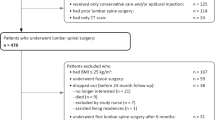Abstract
Purpose
The lumbar epidural lipomatosis (LEL) is a rare disease that can cause sciatic pain syndrome or neurological deficits comparable to symptoms caused by a classical spinal canal stenosis. In severe cases surgical decompression was conducted. However, the outcome after decompressive surgery has only been investigated in small case series. In this study we compared the outcome of LEL patients after microsurgery with the outcome of patients with classical spinal stenosis (CSS).
Methods
Patients with LEL (n = 38) and patients with CSS (n = 51), who received microsurgical decompression, were followed in a prospective observational study for 3 years. The clinical results including the Oswestry Disability Index, Numeric Pain Rating Scale (NRS), Roland and Morris Disability Questionnaire, the Short Form-36 Score and the Walking Distance were analysed and compared between both groups.
Results
Patients with LEL improved significantly after microsurgical decompression in a 3-year follow-up concerning back pain, leg pain and pain-associated disability equal to patients with CSS (NRSback_LEL_preop. = 6.4; NRSback_CSS_preop. = 6.3; NRSback_LEL_3-years = 3.2; NRSback_CSS_3-years = 3.6; NRSleg_LEL_preop. = 6.3; NRSleg_CSS_preop. = 6.5; NRSleg_LEL_3-years = 2.5; NRSleg_CSS_3-years = 2.9; ODILEL_preop. = 52.7; ODICSS_preop = 51.8; ODILEL_3-years = 32.3; ODICSS_3-years = 27.6). The microsurgical decompression had a positive effect on the health-related quality of life, and patient satisfaction was high in both groups (LEL group—71%, CSS group—69%).
Conclusions
LEL can influence the quality of life dramatically and cause a high degree of disability. A surgical decompression is a safe and effective procedure with a good clinical outcome comparable to the results in patients with an osteoligamentous spinal stenosis. Therefore, microsurgical decompression can be recommended in patients with LEL if conservative treatment fails.
Graphical abstract
These slides can be retrieved under Electronic Supplementary Material.



Similar content being viewed by others
References
Morishita S, Arai Y, Yoshii T et al (2018) Lumbar epidural lipomatosis is associated with visceral fat and metabolic disorders. Eur Spine J. https://doi.org/10.1007/s00586-018-5584-2
Malone JB, Bevan PJ, Lewis TJ et al (2018) Incidence of spinal epidural lipomatosis in patients with spinal stenosis. J Orthop 15:36–39. https://doi.org/10.1016/j.jor.2017.11.001
Borré DG, Borré GE, Aude F, Palmieri GN (2003) Lumbosacral epidural lipomatosis: MRI grading. Eur Radiol 13:1709–1721. https://doi.org/10.1007/s00330-002-1716-4
Ishikawa Y, Shimada Y, Miyakoshi N et al (2006) Decompression of idiopathic lumbar epidural lipomatosis: diagnostic magnetic resonance imaging evaluation and review of the literature. J Neurosurg Spine 4:24–30. https://doi.org/10.3171/spi.2006.4.1.24
Barrey C, Roussouly P, Le Huec J-C et al (2013) Compensatory mechanisms contributing to keep the sagittal balance of the spine. Eur Spine J 22(Suppl 6):S834–S841. https://doi.org/10.1007/s00586-013-3030-z
Barrey C, Roussouly P, Perrin G, Le Huec J-C (2011) Sagittal balance disorders in severe degenerative spine. Can we identify the compensatory mechanisms? Eur Spine J 20 Suppl 5:626–633. https://doi.org/10.1007/s00586-011-1930-3
Thomé C, Zevgaridis D, Leheta O et al (2005) Outcome after less-invasive decompression of lumbar spinal stenosis: a randomized comparison of unilateral laminotomy, bilateral laminotomy, and laminectomy. J Neurosurg Spine 3:129–141. https://doi.org/10.3171/spi.2005.3.2.0129
Weinstein JN, Tosteson TD, Lurie JD et al (2010) Surgical versus nonoperative treatment for lumbar spinal stenosis four-year results of the spine patient outcomes research trial. Spine (Phila Pa 1976) 35:1329–1338. https://doi.org/10.1097/BRS.0b013e3181e0f04d
Lee M, Lekias J, Gubbay SS, Hurst PE (1975) Spinal cord compression by extradural fat after renal transplantation. Med J Aust 1:201–203
Badami JP, Hinck VC (1982) Symptomatic deposition of epidural fat in a morbidly obese woman. Am J Neuroradiol 3:664–665
Yildirim B, Puvanesarajah V, An HS et al (2016) Lumbosacral epidural lipomatosis: a retrospective matched case-control database study. World Neurosurg 96:209–214. https://doi.org/10.1016/j.wneu.2016.08.125
Al-Yafeai R, Maghrabi Y, Malibary H, Baeesa S (2017) Spinal cord compression secondary to idiopathic thoracic epidural lipomatosis in an adolescent: a case report and review of literature. Int J Surg Case Rep 37:225–229. https://doi.org/10.1016/j.ijscr.2017.06.041
Borstlap ACW, van Rooij WJJ, Sluzewski M et al (1995) Reversibility of lumbar epidural lipomatosis in obese patients after weight-reduction diet. Neuroradiology 37:670–673. https://doi.org/10.1007/s002340050177
Kniprath K, Farooque M (2017) Drastic weight reduction decrease in epidural fat and concomitant improvement of neurogenic claudicatory symptoms of spinal epidural lipomatosis. Pain Med. https://doi.org/10.1093/pm/pnw313
Fassett DR, Schmidt MH (2004) Spinal epidural lipomatosis: a review of its causes and recommendations for treatment. Neurosurg Focus 16:E11. https://doi.org/10.3171/foc.2004.16.4.12
Cushnie D, Urquhart JC, Gurr KR et al (2018) Obesity and spinal epidural lipomatosis in cauda equina syndrome. Spine J 18(3):407–413. https://doi.org/10.1016/j.spinee.2017.07.177
Weinstein JN, Lurie JD, Tosteson TD et al (2007) Surgical versus nonsurgical treatment for lumbar degenerative spondylolisthesis. N Engl J Med 356:2257–2270. https://doi.org/10.1056/NEJMoa070302
Fogel GR, Cunningham PY, Esses SI (2005) Spinal epidural lipomatosis: case reports, literature review and meta-analysis. Spine J 5:202–211
Ferlic PW, Mannion AF, Jeszenszky D et al (2016) Patient-reported outcome of surgical treatment for lumbar spinal epidural lipomatosis. Spine J 16:1333–1341. https://doi.org/10.1016/j.spinee.2016.06.022
Ross R, Shaw KD, Rissanen J et al (1994) Sex differences in lean and adipose tissue distribution by magnetic resonance imaging: anthropometric relationships. Am J Clin Nutr 59:1277–1285. https://doi.org/10.1093/ajcn/59.6.1277
Theyskens NC, Paulino Pereira NR, Janssen SJ et al (2017) The prevalence of spinal epidural lipomatosis on magnetic resonance imaging. Spine J 17:969–976. https://doi.org/10.1016/j.spinee.2017.02.010
Al-Omari AA, Phukan RD, Leonard DA et al (2016) Idiopathic spinal epidural lipomatosis in the lumbar spine. Orthopedics 39:163–168. https://doi.org/10.3928/01477447-20160315-04
Author information
Authors and Affiliations
Corresponding author
Ethics declarations
Conflict of interest
All authors declare that they have no conflict of interest.
Ethical approval
All procedures performed in studies involving human participants were in accordance with ethical standards of the institutional research comittee (reference number: EA1/101/17) and with the 1964 Helsinki declaration and its later amendments or comparable ethical standards.
Informed consent
All authors confirmed consent for publication.
Electronic supplementary material
Below is the link to the electronic supplementary material.
Rights and permissions
About this article
Cite this article
Bayerl, S.H., Dinkelbach, M., Heiden, P. et al. Treatment results for lumbar epidural lipomatosis: Does fat matter?. Eur Spine J 28, 69–77 (2019). https://doi.org/10.1007/s00586-018-5771-1
Received:
Revised:
Accepted:
Published:
Issue Date:
DOI: https://doi.org/10.1007/s00586-018-5771-1




